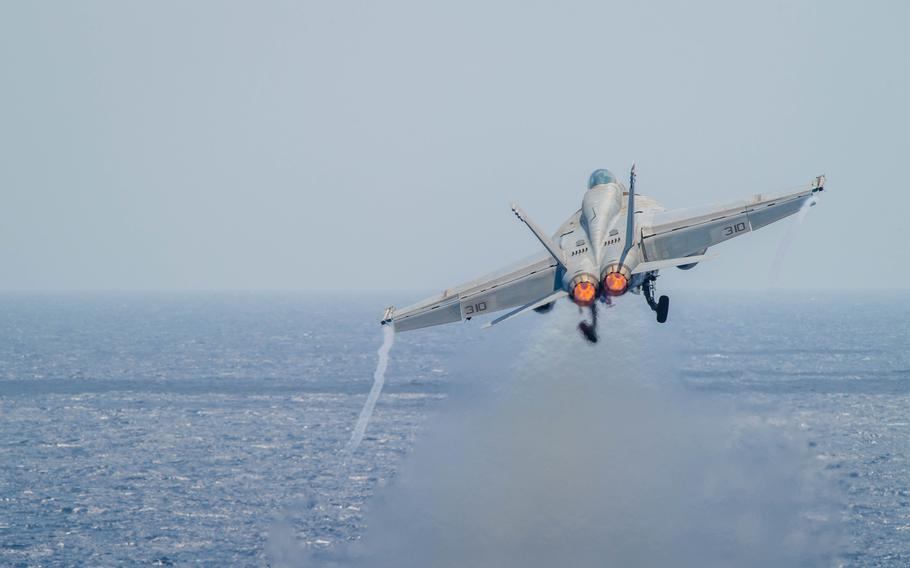
An F/A-18E Super Hornet launches off the flight deck aboard the Nimitz-class aircraft carrier USS Theodore Roosevelt in the South China Sea, March 27, 2024. The United States and three of its Pacific allies planned a military exercise in the South China Sea, a move to demonstrate their rights to navigate and overfly the region freely, according to a statement from all four defense chiefs. (Aaron Haro Gonzalez/U.S. Navy)
TOKYO — The United States and three of its Pacific allies planned a military exercise in the South China Sea on Sunday, a move to demonstrate their rights to navigate and overfly the region freely, according to a statement from all four defense chiefs Friday.
The U.S., Australia, Japan and the Philippines planned a “maritime cooperative activity” in the Philippines’ exclusive economic zone involving naval and air force units, according to the statement posted on the U.S. Department of Defense website.
China apparently responded Sunday with its own “joint naval and air strategic patrol” in the South China Sea, according to the official China Military Online website.
“All military activities disrupting the South China Sea situation and creating buzzes are under control,” according to the brief report, which cited a statement from the Chinese military’s Southern Theater Command on Sunday morning.
The DOD release did not specify where the exercise would take place, which assets would be involved or what capabilities they would demonstrate. Email queries to U.S. 7th Fleet at Yokosuka Naval Base and U.S. Forces Japan did not draw an immediate response Sunday morning.
Ultimately, the statement reads, the exercise will strengthen the four powers’ ability to work together using one another’s military training methods, equipment and tactics.
“Every country should be free to conduct lawful air and maritime operations. These activities with our allies Australia, Japan, and the Philippines underscore our shared commitment to ensuring that all countries are free to fly, sail, and operate wherever international law allows,” Defense Secretary Lloyd Austin said in the statement. “Our operations together support peace and stability at the heart of our shared vision for a free and open region.”
Australian Defence Minister Richard Marles, Japanese Defense Minister Minoru Kihara and Philippines Secretary of National Defense Gilberto Teodoro Jr. endorsed the announcement with individual statements of their own.
“The series of bilateral and multilateral [maritime cooperative activities] is a step in building our country’s capacity for individual and collective self-defense,” Teodoro wrote.
“Japan believes the issue concerning the South China Sea is directly related to the peace and stability of the region and is a legitimate concern of the international community…,” Kihara wrote. “Japan opposes any unilateral changes to the status quo by force, such attempts as well as any actions that increase tensions in the South China Sea.”
The U.S. is committed to the Philippines’ defense, along with Japan’s, according to their mutual defense treaties.
None of the defense chiefs’ statements mentioned China as a threat to “lawful air and maritime operations” but the setting and timing provide context to the exercise.
The exclusive economic zone is generally an area within 230 miles of a country’s territorial seas in which it claims jurisdiction over all the resources, living and nonliving. The Philippines’ EEZ is contested by China, which claims nearly all the South China Sea over several other rival nations.
That contest has played out in a series of escalating altercations between Philippine resupply ships and the Chinese and Filipino coast guards at Second Thomas Shoal, where the Philippines maintains an outpost in a rusting World War II-era vessel, the BRP Sierra Madre.
Chinese coast guard vessels have intercepted or blocked attempts to resupply the Sierra Madre, colliding with or using water cannons to deter the Philippine ships. Injuries to Filipino crew members and damage to resupply vessels have resulted.
Philippine President Ferdinand Marcos Jr. said his government would act against the continuing attacks by China’s coast guard and its suspected militia ships, saying “Filipinos do not yield,” The Associated Press reported March 28.
The defense chiefs’ statements reaffirmed a 2016 decision by a United Nations tribunal upholding the Philippines’ claim to maritime territory in the South China Sea, a decision China disregards.
“We have made clear China’s position on the issue many times,” Chinese Foreign Ministry spokesman Wang Wenbin said at a routine press conference Wednesday. “Let me say again that what caused the maritime disputes between the two countries to heat up is that the Philippines, backed by external forces, has been going back on its words and provoking China.
“China remains unwavering in safeguarding our territorial sovereignty and maritime rights and interests,” he said, according to a transcript on the Foreign Ministry website.